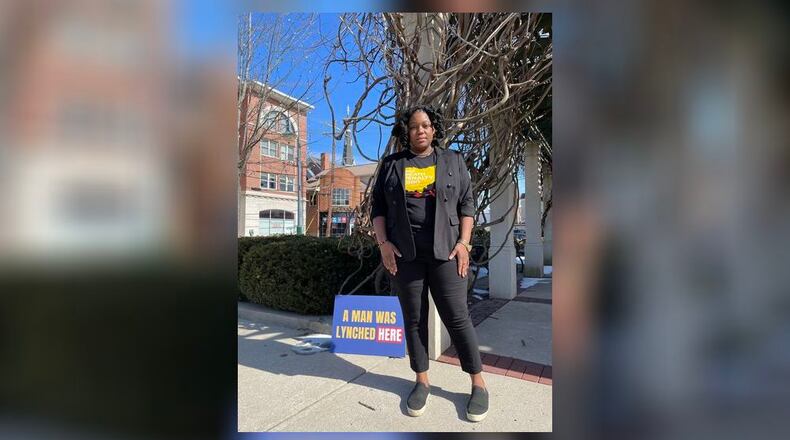Allison Cohen, of Ohioans to Stop Executions, one of four sponsors of the program, said people of color have historically been overrepresented on death row and that remains true in Ohio, where 56 percent of those on death row are Black while Blacks account for 13 percent of the state’s population.
She is a Cincinnati resident who grew up in Reily Twp. and graduated from Badin High School.
A bigger part of the problem, Cohen said, is the number of those on Death Row who are found innocent of the charges that put them there
“The same racial disparities that were present in the very beginnings of our country’s judicial — and extrajudicial — system persist today. In 2020, the Death Penalty Information Center put out a report called ‘Enduring Justice’ which cites many examples,” Cohen said. “These echoes of doubt can also be found in modern cases: the commutation of Arthur Tyler in 2014 after the governor found there was too much doubt to proceed with an execution, the exoneration of Derrick Jamison out of Hamilton County who came within 90 minutes of his execution.”
This situation goes back to lynchings, which Cohen said began to diminish in the 20th century but were replaced by the death penalty.
Oxford was chosen as the site for the anti-death penalty program because of the two well-publicized lynching incidents in which Black men were arrested but taken from their cells by a mob and hanged. Those were Simon Garnett in 1877 and Henry Corbin in 1892.
Garnett was lynched at the site approximately where the police station is now located, Cohen said, but there is some question about the exact location for Corbin’s hanging. It is believed Corbin’s death occurred in the Uptown area approximately where the performance pavilion is located, but she said the family has always contended it occurred at the site of the Black Covered Bridge on Morning Sun Road. For that reason, the “From Noose to Needle” program videos incorporated both locations.
The history marker recalling the two lynching deaths is located in the western Uptown park.
“We see similarities in the stories of some of the men who were lynched and the men have found themselves on death row. Henry Corbin was dragged from his cell and lynched when there were still questions surrounding his guilt,” Cohen said.
Ohioans to Stop Executions was one of four sponsors of the program along with the Cincinnati NAACP, Greater Cincinnati YWCA and Conservatives concerned About the Death Penalty.
Another participant was the Rev. Dr. Crystal Walker, executive director of the Greater Dayton Christian Connection, who opposes the death penalty even in the face of the murder of her own son at age 28 several years ago.
“I opposed it before that. When I was in seminary, I did a paper opposing the death penalty. I was told I only opposed it because I had not had a family member murdered,” she said, explaining she also understands the feelings of wanting revenge. “For two weeks, I wanted that person to die but I thought of the pain I was experiencing and did not want that pain on any other mother, father, sister, brother. Even if the young man who murdered my son would die, his family would go through pain.”
The Rev. Walker said she is involved in a prison ministry and reflects on the murder of her son through the people she meets in prison now.
“People make mistakes. God came down to heal. People can be rehabilitated. There are lots of mistakes, lots of exonerees,” she said.
Cohen said the death penalty flowed from lynchings.
“In some instances, executions were promised to deter lynchings from occurring. Theodore Roosevelt condemned lynching but in the same speech, insisted that capital punishment remain law for rapes committed by Black men,” she said. “As visual spectacle, lynchings and public executions varied little in appearance. The patterns of racial disparities that led to racially-motivated violence in the past still contribute to modern death penalty trends. Rape and violence against white victims was often what led to lynching – as was the case of the two men who were lynched in Butler County. A recent study found that in Hamilton County, Black men are three to five times more likely to receive the death penalty if their victim is white. This pattern isn’t unique to southwest Ohio.”
Videos, available on YouTube, include one with scenes from Uptown and the Black Covered Bridge with named of lynching victims superimposed and another at the covered bridge with comments from Jennifer Pryor, director of organizing and community engagement for Ohioans to Stop Executions, giving facts about the history of lynching and the death penalty.
Cohen said Oxford was chosen for the program because of the public recognition of the two lynching incidents here.
“The hook is the focus on Southwestern Ohio. Studies show the pattern of racial discrimination echoes from 130 years ago, with Henry Corbin,” she said. “In practice, the death penalty still targets Black men disproportionately and seeks their execution even when questions around their guilt persist.”
About the Author
